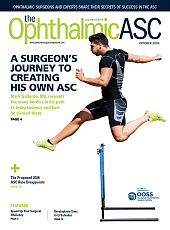This transcript has been edited for clarity.
Hi, I'm Diana Do, MD. Welcome to Retinal Physician. I'm here with my friend and colleague Roger Goldberg, MD. You had some exciting data on pegcetacoplan (Syfovre; Apellis Pharmaceuticals), a treatment for geographic atrophy. Can you tell us the highlights?
Roger Goldberg, MD: Sure. So, we now have 4-year data of patients on continuous therapy with pegcetacoplan with geographic atrophy, treated either monthly or every other month. These are the first 2 years of DERBY and OAKS, and then those patients rolled over into GALE. If they made it into GALE, they had about an 80% chance then of finishing the next 2 years of treatment. The patients originally randomized to sham were crossed over.
What do we see with 4 years of continuous treatment? We see about 1-1/2 disc areas of tissue preserved. This was in the monthly treatment arm, nonsubfoveal population, so those faster-growing GA lesions getting our most aggressive therapy. That's quite a significant amount of tissue preserved. We continue to see this increasing effect size over time, so the longer you're on pegcetacoplan the better it seems to work. This was seen both in the patients over time, a 10% to 15% further reduction in GA growth in the second 2 years vs the first 2 years. Similarly, the crossed-over patients after 2 years of observation then 2 years of treatment, they had about 1.1 mm2 of tissue preserved vs almost triple that in the patients on 4 years of treatment.
Finally, what I think is probably the most exciting [data], because we’ve all been waiting for this structure-function correlation to occur—it didn't really manifest itself in the first 2 years of treatment, but now that patients are on longer-duration therapy we are starting to see on functional benefits on microperimetry. What I'm sharing here at ASRS is that there is about a one-third risk reduction of the central 4 or central 16 loci on microperimetry—so the most critical real estate—on preventing those from progressing to an absolute scotoma. When you think about that, that really does signify that we should be thinking about intervening earlier because you’re going to give your patients more time with those central [areas of] critical real estate still preserved. That's exciting data.
Finally, I'll just add that the safety data in GALE seems very consistent with what we saw in DERBY and OAKS. No new safety signals, still no cases of occlusive vasculitis in the clinical trials. In the real world I think they're up to over 600,000 injections, so we’re starting to get a good sense of what that rate is in the real world and the real-world safety profile.
Diana Do, MD: Great! I really love that long-term data and now as you said the structure and function is coming together, which is compelling data. Thank you so much, Roger, really appreciate it. RP








